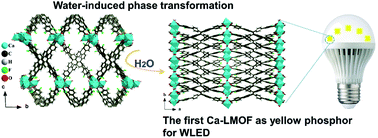Achieving a blue-excitable yellow-emitting Ca-LMOF phosphor via water induced phase transformation†
Abstract
Luminescent metal–organic frameworks (LMOFs) with diverse structural features and promising fluorescence-based applications have attracted wide attention in the past two decades. In this work, a LMOF with the formula [Ca4(tcbpe-F)2(H2O)3] (1, LMOF-411) has been constructed from calcium (Ca) and 1,1,2,2-tetrakis(4-(4-carboxyphenyl)phenyl)ethene (H4tcbpe-F). Compound 1 features a three-dimensional framework with a 10-nodal net topology. Due to the relatively high hydration energy of Ca2+, compound 1 readily transforms into a new phase formulated as [Ca(H2tcbpe-F)(H2O)2] (1′) upon exposure to water. Combining experimental characterization and theoretical calculations, we elucidated the mechanism of H2O-induced phase transition from 1 to 1′. Notably, the water induced phase transformation can be detected visibly from the change in luminescence, which originates from the fluorescent linker. Compound 1 emits green light (λem = 490 nm) under UV excitation, while compound 1′ emits bright yellow light (λem = 550 nm) under blue excitation (450 nm). Compound 1′ represents the first Ca based LMOF yellow phosphor and its luminescence quantum yield reaches 68%. It can be coated directly onto a commercial blue light-emitting-diode (LED) chip to fabricate a white LED (WLED).



 Please wait while we load your content...
Please wait while we load your content...